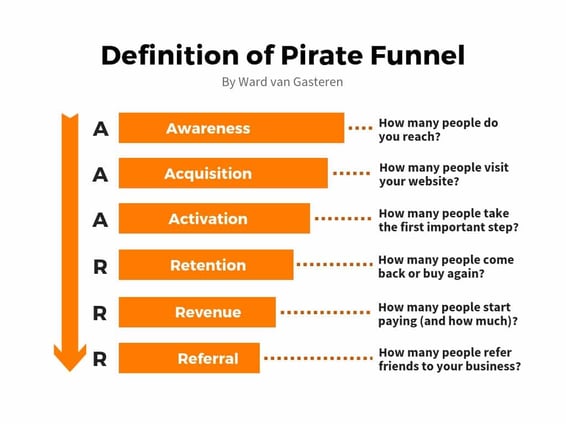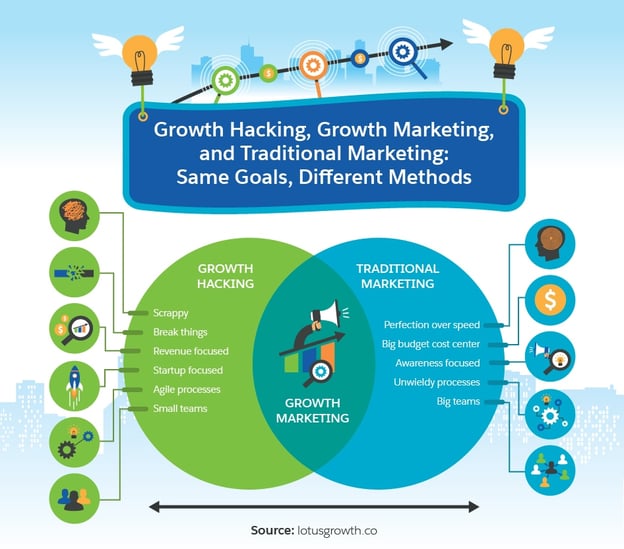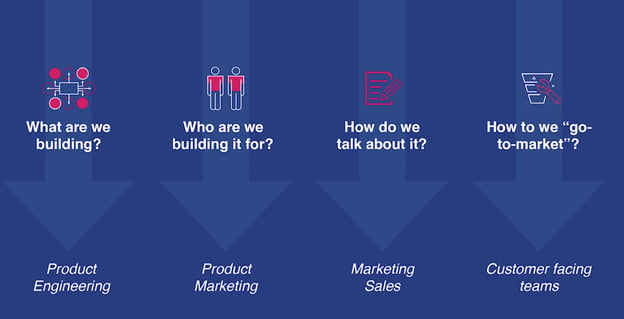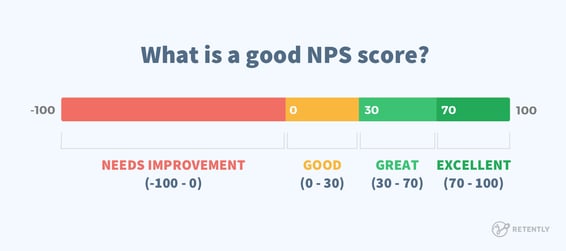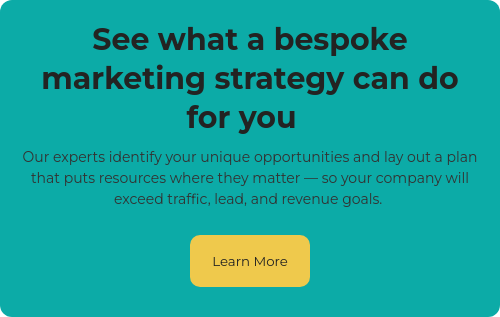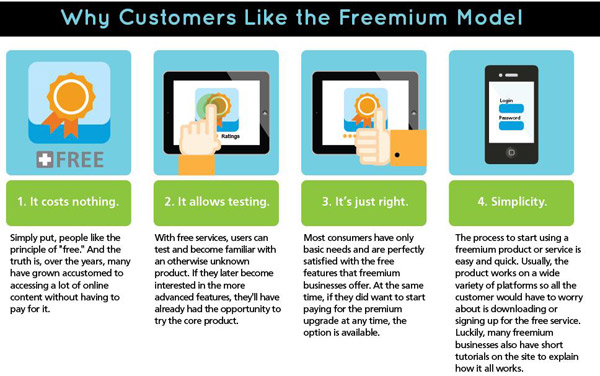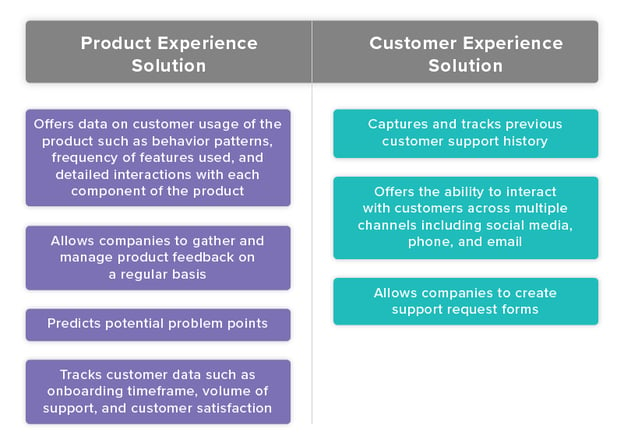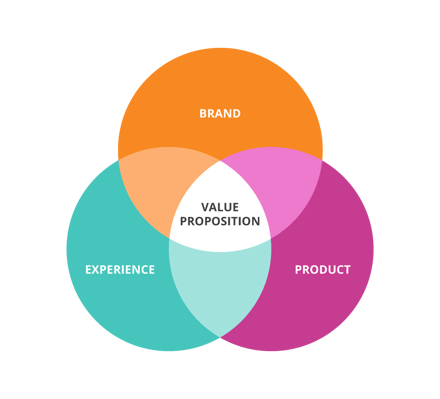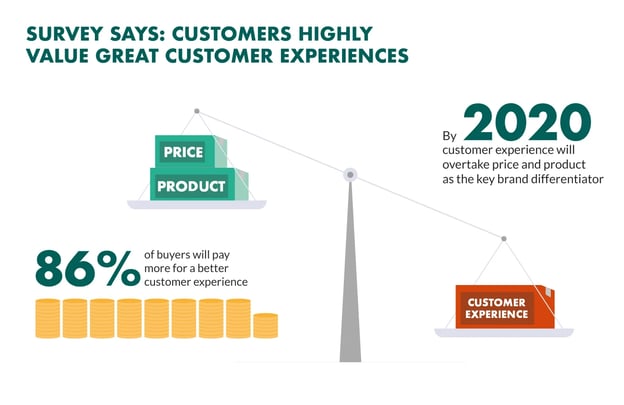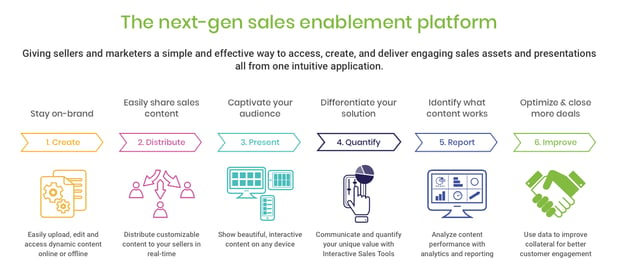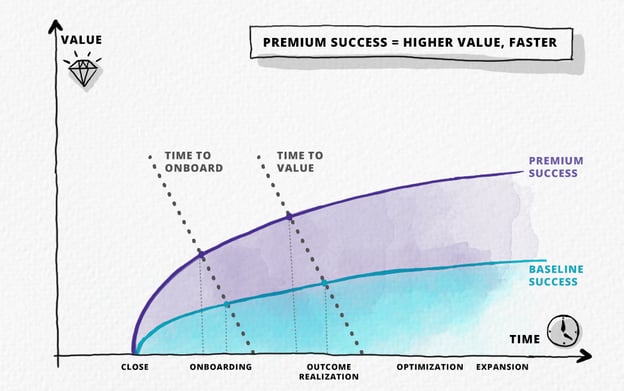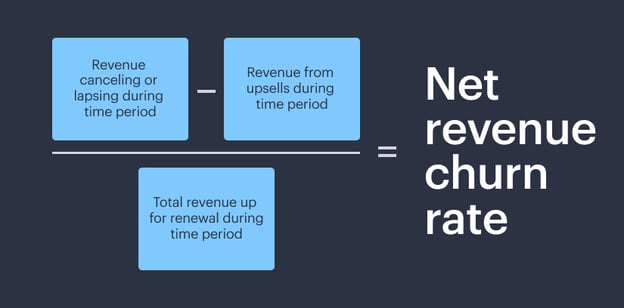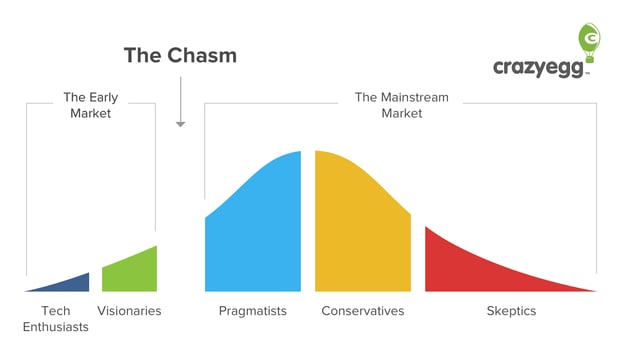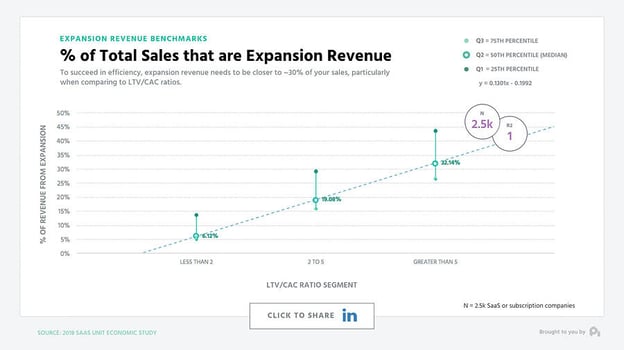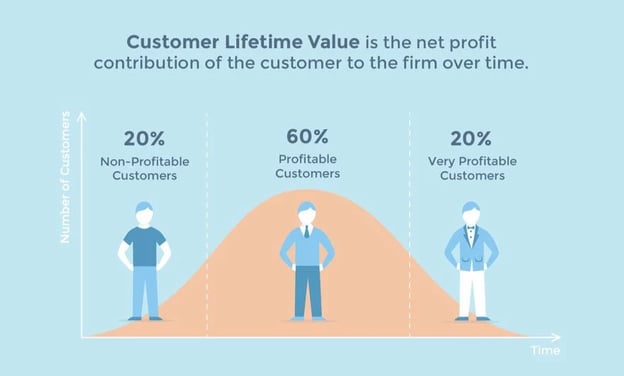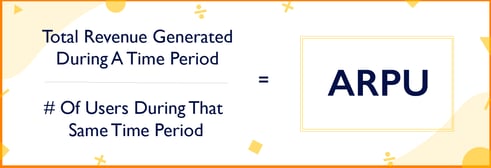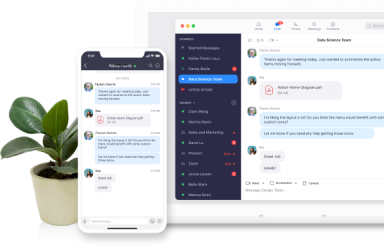You have a great product. You have a marketing strategy that’s focused on growth. But…nothing’s happening. That needle isn’t moving, and you’re beginning to wonder if this whole growth marketing thing is a lot of stuff and nonsense. We’re here to tell you that it’s not.
But if you aren’t seeing the results you want, it could be that your strategies — marketing your product and marketing for growth — are siloed. Instead of leveraging one against the other, you’re doubling your effort in trying to make each one a success on its own.
If you want to achieve next-level growth, you’re going to have to take a more holistic approach. For SaaS brands like yours, a long sales cycle might feel like an insurmountable obstacle to quick and sustainable growth, but it’s not. By combining product marketing and growth marketing into a single, strategic methodology, you can create consistent demand for your SaaS product and fill your pipeline with leads to achieve long-term, sustainable growth.
Let’s find out how.
What is Growth Marketing?
Put on your eye patch because you’re about to get hooked by the pirate funnel. It’s called the pirate funnel because “AAARRR.” Charming, right? But it’s not just a whimsical way to remember the growth marketing funnel stages. It’s a proven methodology for creating a holistic approach to reaching your ideal buyer wherever they are and converting them to achieve maximum growth.
Growth marketing takes a holistic approach to the funnel, as opposed to traditional marketing, where marketers tend to hang out around the top. Growth marketing is also data-driven, always seeking to measure success with key business metrics and KPIs.
Growth marketing is built on a cycle of experimentation, analysis, and repetition. It employs some strategies of traditional marketing and utilizes growth hacking tactics to help move the needle on your brand.
Ultimately, the goal is to achieve growth that is measurable, sustainable, and impactful.
But, there are countless ways to design your growth marketing strategy. For SaaS brands, one of the best ways is to combine it with your product strategy to achieve product-led growth. Here’s how to get started with product growth marketing.
What Is Product-Led Growth?
“Product growth marketing” might sound like a contradiction. Product marketers tend to focus more on, well…the product…while growth marketers hone in on the users. Product marketing also often lingers on the pre-sale portion of the pipeline, while growth marketing narrows in on the post-sale phase, including retention and referral.
However, product-led growth marketing takes a big-picture approach, leveraging marketing strategies around both the product and the consumer with the singular aim of achieving growth.
In this methodology, both the product and the user are equally important and both drive the strategy and the tactics used to achieve growth.
What Are the Benefits of Product-Led Growth?
More acquisitions, more demand, and more revenue. Sounds like a pretty sweet deal, right? These, of course, are the hoped-for results of any successful growth marketing campaign, but when you put your product front and center, you experience even greater benefits.
Takes Pressure off Your Sales Team
When you market your product first with a growth-focused strategy, you give users all the information they need to make a decision, rather than relying on a sales team to walk them through it. In fact, 75 percent of B2B buyers say they prefer to buy directly from a brand’s website, rather than from a sales rep.
This does, of course, put some of that pressure back on you, requiring you to create content that offers solutions to buyers’ pain points, gains their trust, and positions your brand as the go-to option to meet their needs. It also requires a seamless and simple user experience, so they don’t have to reach out to your sales team for help when signing up for your product.
Efficient Use of Budget Allocation
Which is cheaper: marketing your mostly adequate product to a vast audience of new leads who may or may not be interested…or fine-tuning your product to delight existing customers, then leveraging their reviews and referrals to grow your market share?
You don’t have to run any numbers to reach the conclusion that product-led growth marketing is more cost-effective. Paid ads can only get you so far (at least without blowing your budget to smithereens) and only nets you about 2–5 percent conversions. Organic growth, on the other hand, using your existing customer base and their extended networks, increases both acquisition and retention and drives up your ROI.
Lower Acquisition Cost
When you have customer acquisition built into your product-led growth strategy, through referrals, incentives, and excellent customer service, you lower your overall cost per acquisition. Your product speaks for itself, so you don’t need pricey ads to do it for you. And once customers see the results — through free trials, freemiums, or demos — they become your biggest brand evangelist.
Improved User Experience
Speaking of brand evangelists, if that's what you’re aiming for, you’re going to need to spend a little time evaluating what your users want and need to get the most out of your product. Creating a best-in-class user experience is easier when you lean into product-led growth marketing and the benefits that come along with it are numerous. You’ll find, as noted above, your customer acquisition costs go down and your budget isn’t quite so tight.
Additionally, the improvements you’ll see in user experience will give a lift to your Net Promoter Score, which is calculated by determining how many promoters you have vs. how many detractors.
For SaaS brands, an NPS of 50 will put you in good company with some of the best in the business. Remember though, NPS isn’t a reliable success metric in and of itself, but it can be used to benchmark your performance against that of your competitors.
Why Product-Led Growth Is Becoming Increasingly Important
You might think that all marketing from SaaS brands is product-led, but that simply isn’t the case. Traditional marketers might try to shoehorn a SaaS brand into traditional marketing strategies, while hip growth hackers focus on making a product seem edgy, rather than making it meaningful.
Product-led growth marketing is a comprehensive strategy that addresses both the product and the user, in order to meet buyer pain points and create outspoken brand advocates. And that’s now more important than ever, due to shifting trends in the SaaS landscape.
Buyers Prefer to Learn on Their Own
Who doesn’t love a good DIY? Your buyers certainly do. If they can do it themselves easily and more quickly than relying on a sales team to walk them through it, they will take that opportunity nearly every time.
This is why freemium business models are on the rise. Like growth marketers, customers like to test and experiment. They want to know a product is going to work for them before they break out the credit card, and they’d rather learn on their own terms.
A frictionless, hassle-free experience is what most buyers are looking for, and they won’t believe it until they see it with their own eyes.
Startups Are Expensive to Grow
The good news? The cost to develop your SaaS product is lower than ever. The bad news? That means market saturation with new competitors cropping up almost on the daily. In turn, that means higher marketing costs and higher customer acquisition costs.
Customer behavior also impacts how much you’ll pay to get your startup out into the world. Currently, buyers are 30 percent less likely to want to pay for your product’s features.
How do you mitigate this perfect storm of rising marketing costs and customer resistance? By putting your money where your mouth (or your product) is. An irresistible product creates demand and when you focus on product-led growth, you’re putting your time and your dollars where it really counts.
Product Experience Is a Crucial Part of the Buying Process
What do people hate more than spending money before they’re sold on a product? Having to talk to real human people in order to do it. The text-or-die generation does not want to pick up the phone to figure out how to use your product. If they can’t figure it out based on your website, content, and free trial experience, they’re likely to bounce. This is where product experience becomes critical to your growth strategy.
Note that product experience and customer experience are not one in the same. However, you do have to nail both if you want your SaaS brand to grow.
Why SaaS Teams Are Focused on Product-Led Growth
They say that what’s good for the goose is good for the gander. Applying that analogy to SaaS brands means that what’s good for the product is good for the user. This is where product-led growth marketing differentiates itself from traditional product marketing.
With product-led growth, every department and every part of the process is driven by the product.
It is, however, important to note that this focus on the product is not to the exclusion of all else, but rather with the aim to grow every channel on the front end by ensuring delivery of the highest-quality product possible. In turn, this also ensures growth on the back end by providing a product that users love and want to promote across their networks.
Having your product as your North Star and source of truth isn’t a guarantee for success, but it’s a good guide to follow. If your growth isn’t what you expect, go back to your product. If your customers are less than thrilled, go back to your product. If your sales team is struggling…well, you get the idea.
What Are the Essential Elements of Product-Led Growth?
So, you’re thinking, “Okay, great. I’m sold on product-led growth marketing. But how do I start?” We could tell you it’s easier to just outsource your product growth strategy to an agency (because it kind of is), but if you’re like most SaaS folks, you want to understand it first for yourself. We get it. That’s why we’ve compiled the top essential elements you’ll need to achieve product-led growth.
![6 Simple & Effective Ways to Achieve Product-Led Growth [INFOGRAPHIC]](https://www.firstpagestrategy.com/hs-fs/hubfs/6%20Simple%20%26%20Effective%20Ways%20to%20Achieve%20Product-Led%20Growth%20(2).jpg?width=2505&name=6%20Simple%20%26%20Effective%20Ways%20to%20Achieve%20Product-Led%20Growth%20(2).jpg)
Understand the Value of Your Product
As you already know, cost does not equal value. The value of your product should outweigh the cost if you want users to pony up their hard-earned dollars. Understanding your product’s value begins with evaluating your buyer persona and getting a clear picture of their pain points. How does your product solve for those? Does it make their life easier? Does it save them time, hassle, or headaches? Can they live without it? When you know the answers to those questions, you’ll have a better handle on your product value.
Just remember, overall value isn’t influenced by your product alone.
Your value is found in between your product, your brand, and your user experience. When you evaluate these three together, you’ll understand the true value of what you have to offer.
Demonstrate the Perceived Value Early On
One key of product-led growth marketing is showing, rather than telling. Your customers don’t want to hear how great your product is; they want to see it in action. Remember, most buyers want to do the research and learning themselves when it comes to your product, but if they don’t see demonstrated value from the offset, they’re likely to drop off the radar.
But if they do perceive value that’s clearly demonstrated by your free trial or freemium and backed up by customer experience, they’re far more likely to convert to paying customers.
Deliver on the Promise
Now that you understand the value of your product and the value your customers perceive, you’ll have a better idea of whether or not you’re delivering on the promises your product makes.
Consumers are savvier than ever, and they aren’t going to stick around long to use a product that doesn’t do everything it says it will do.
When it comes to your product, over-promising and under-delivering can be a fatal blow. But you don’t have to under-promise and over-deliver to keep your customers on the hook. It’s really as simple as doing the things you say your product is going to do.
Reduce Friction
When it comes to marketing a SaaS product, friction is basically a four-letter word. Users want a seamless, easy onboarding experience for quick adoption…and you want that for them, too. But there are different types of friction that occur throughout the process, and you have to understand them all before you can knock down the barriers they cause.
Friction keeps users from meeting their goals and causes them frustration and distress in the process. Look for friction points throughout your onboarding process and work to eliminate them to give users a hassle-free experience.
Drive Demand with Product Features
A word of caution here: simply creating new features and upgrades won’t bring you measurable growth. As you’ve probably learned while designing your product, it’s not an “if you build it, they will come” scenario. So creating features arbitrarily in the hopes they will drive sales is a futile effort.
Instead, utilize the foundations of growth marketing to dive deep into your buyer persona and understand what they want, what they need, and how your product can solve their pain points. Use that to guide the features and updates you roll out. One of the easiest ways is to ask your existing customers their opinion. A quick survey can provide priceless insight into how to meet their demand.
Make Sure Sales and Marketing Work Together
Early on in this guide, we mentioned that taking a siloed approach to product marketing and growth was a surefire way to guarantee missed opportunities and sluggish success. To truly implement a product-led growth strategy, you have to be ready to collaborate. It’s a big sandbox with room for everyone, but you have to make sure you’re playing together if you want to grow.
This is where a strong sales enablement strategy comes into play.
Sales enablement ensures cross-team collaboration that aligns with your product-led growth strategy, because you’re delivering the right resources to your sales team to help them do their job better, more efficiently, and more effectively.
What Metrics Should SaaS Teams Track for Product-Led Growth Marketing?
Product-led growth marketing must be data-driven. Tracking the right metrics will help guide your strategy and make you far more likely to achieve your goals. There are countless growth metrics out there, but these are the top ones related to SaaS that will enable you to be agile, adaptable, and prepared for growth.
Time to Value
How long does it take your customers to realize the value they perceived in your product when they signed up? Time to Value (TtV) is a key success metric for SaaS brands. Why? Because when you lower TtV, freemium or trial users are much more likely to convert to paid subscribers.
To achieve long-term growth, you need to ensure your customers see the value in your product as close to onboarding as possible and then deliver on the expected outcomes and deliverables.
Net Revenue Churn
Net revenue churn rate gives you insight into how many customers cancel their subscription vs. how many upgrade or add on to their subscription, stacked up against the potential renewal revenue in a given period.
If you’re losing potential revenue to churn and not making it up in customer upsells, you need to take a step back and review your product growth strategy.
Feature Adoption Rate
With any SaaS product, there’s an adoption curve that spans from the very early adopters all the way to the skeptics. This same curve can be applied to feature adoption as well. But be on the lookout, because there’s a steep cliff between your early market and your mainstream market and customer drop-off is high.
The chasm is a graveyard of once-promising early adopters, and if you find this gap exists in your own adoption process, you’ll need to do some digging to understand what’s causing it. Look at when and why customers are dwindling. Is it before the release of new features or after they’ve adopted them? Evaluating your features against these metrics will help you make changes in what you’re offering and how you’re distributing information about it to your customers.
Expansion Revenue
At its most basic, expansion revenue is another way of noting upselling or cross-selling to your existing market.
Expansion revenue includes any purchase that is above and beyond a customer’s initial investment in your product. At the most successful SaaS companies, expansion revenue is 30 percent (or more) of total revenue.
Customer Lifetime Value
Customer lifetime value (CLV) predicts the total profit generated by each customer from the time they onboard to the time they end the relationship.
The longer the lifecycle of your average customer (and the larger the percentage of average or high-performing customers), the more growth you’re likely to achieve.
Average Revenue Per User
Average revenue per user (ARPU) is a fairly straightforward calculation that will tell you how much revenue each customer generates within a given time period.
ARPU is typically tracked monthly, but if you’re noticing a lot of fluctuation and drop-off, you may want to track daily or weekly until you get a handle on the cause and find a solution to improve your numbers.
Product-Qualified Leads
Forget MQLs and SQLs. In product-led growth marketing, PQLs are where it’s at. Product qualified leads rely on the behavior your customers use within your product to generate leads that convert to sales.
Most of the time, PQLs will be freemium or free trial users and analyzing their data will give you insight into how they’re using your product and what they need in order to upgrade to paid and premium services.
Examples of Product-Led Growth Companies
Need some inspiration to get started on your product-led growth marketing plan? Look at how the big players are doing it, learn from their successes, and adopt their most effective tactics when plotting out your own product growth strategy.
Calendly
“Going viral” doesn’t have to mean your YouTube video gets a million views. Viral marketing principles are well-aligned with growth marketing, and that’s exactly what Calendly banked on when designing its collaborative product.
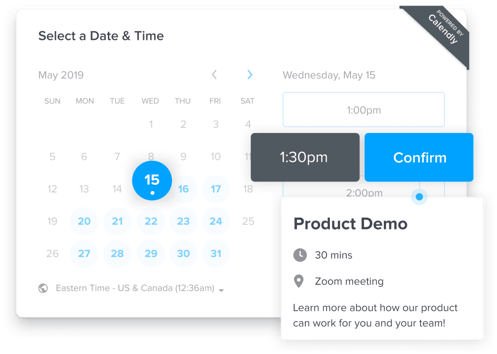
Calendly is so great at what it does because it requires a reciprocal relationship between the user and anyone they’re connecting with to schedule a meeting. This creates a viral cycle and a ready-made referral loop that captures new users and delivers on the product value immediately.
Zoom
Zoom has become so widespread in the last couple of years that the brand name has become a verb with its own unique meaning. The video communications platform has been a leader in the freemium business model, allowing users to schedule 40-minute meetings at no cost.
In 2020, as video chat surged, Zoom dropped the time limit to bring in new customers. The limit was eventually reinstated, but not before they had gained an almost cult following and many new paid subscribers.
Now, Zoom is expanding its product features by offering tools and upgrades like instant messaging and chat, virtual event hosting, cloud storage, and more.
SurveyMonkey
If you’re starting to notice a theme (viral marketing at its finest), you’re onto something. SurveyMonkey also joins the previous brands in creating “set it and forget it” marketing opportunities through its product-led marketing.
SurveyMonkey has built the same type of viral loop into its product that Calendly used to great effect. Every time a user creates and sends a survey, anyone who clicks and responds will be exposed to the SurveyMonkey brand.
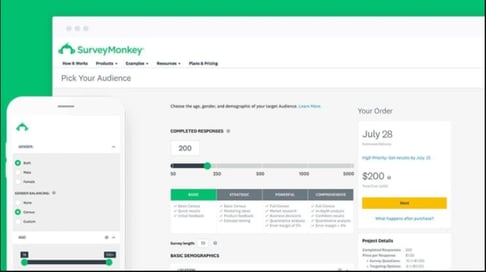
If they see the value in the service, which should be obvious in their interaction with the product, they end up wanting to learn more. At the very least, they are now newly aware of the product SurveyMonkey is providing and will have the brand top of mind.
Slack
Slack is an app that has taken the professional world by storm, especially in the era of remote work. That’s because, in addition to freemium plans and trials, Slack has a low learning curve, quick adoption rate, and frictionless onboarding process.
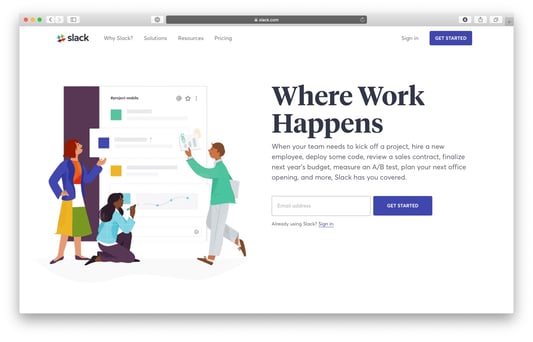
Most Slack users come to the brand via coworkers or employers, but what really sells them is the TtV (time to value) Slack maintains. Almost immediately, users are in the program and learning features that will help them do their work effectively and efficiently, delivering on the brand’s promises.
This product-led focus is what helped Slack burst onto the scene and achieve a $7 billion (yes, with a “B”) valuation in just five years.
Conclusion: The Best SaaS Companies Focus on Product-Led Growth
Product growth marketing and SaaS go hand in hand.
However, designing a product-led growth strategy can be overwhelming and time-consuming. If you want to save time, maximize your budget, and achieve long-term, sustainable growth with your amazing product offering, a growth marketing agency may be the right choice.
At First Page, our team of experts understands SaaS brands, product-led marketing, and key metrics to drive you toward measurable, meaningful growth. Check us out to learn more, and see if we might be a good fit for your SaaS brand.
Frequently asked questions about Product Growth Marketing
Related questions asked on Google:
What does a growth marketer do?
Growth marketers utilize the scientific method to hypothesize, experiment and develop strategies that lead to long-term, sustainable growth. They are data-driven and focused on numerous business metrics for end-to-end funnel optimization. Growth marketers leverage the extended AAARRR funnel (the pirate funnel) and use A/B and multivariate testing to track and measure growth.
What does a product marketer do?
Product marketers keep their focus on positioning, branding and launching a product. They work to develop buyer personas to identify and penetrate their market, create a frictionless onboarding process, and address customer feedback to make adjustments to the product for easier, wider adoption.
What is the difference between growth marketing vs. product marketing?
Generally, product marketing focuses on the pre-sale phase, while growth marketing sets its sights on the post-sale phase. However, the two can be combined into a product-led growth marketing strategy that addresses customer needs at all stages of the funnel.
Why is product marketing important?
Without proper marketing, a product, no matter how amazing it is, is destined to fail. Product marketing uses buyer personas to uncover opportunities for greater market penetration and market share, raises awareness of new products, and creates interest around it. Product marketers are experts in identifying customer pain points and communicating solutions that will meet their needs.
How does product marketing work with growth marketing?
Product marketing and growth marketing complement each other. Product marketing happens more in the pre-sale phase, while growth marketing occurs in the post-sale phase. However, both use data and experimentation to test hypotheses and build strategies that drive growth.
What companies are good at product-led growth marketing?
Some of the brands most well-known for implementing product-led growth marketing strategies are Dropbox, Shopify and Slack. These brands have leveraged growth marketing tactics centered around their products to drive long-term growth, build their customer base and increase leads, traffic and revenue.


